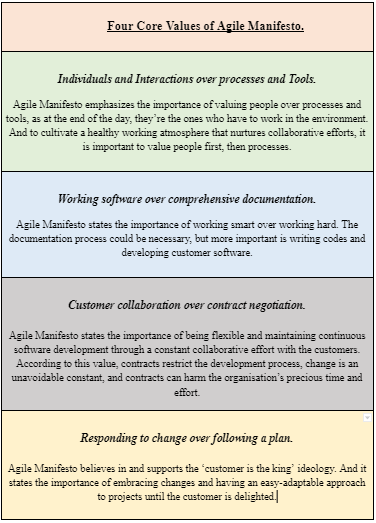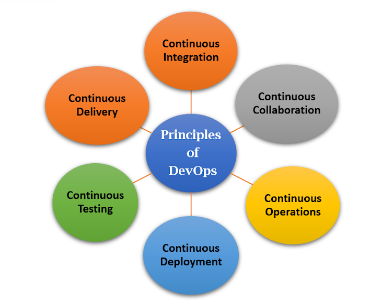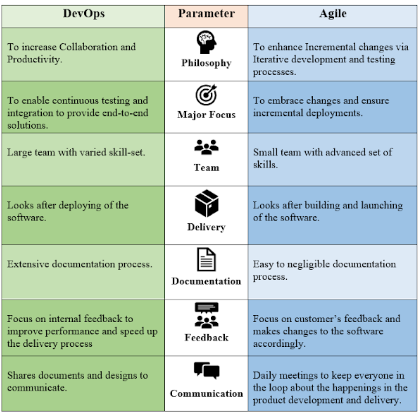Reading Time : 1 Mins
DevOps vs Agile: What is the Best Strategy for Business Growth?
Loves getting creative with mundane topics in addition to geeking out over books and movies.
Today, businesses are constantly changing their business strategies to optimize workflow and maximize productivity. It has become essential to value the customer, listen to their needs & requirements, feedback, and provide premium quality products. And this need to provide the best products to the customers with the minimum delivery time has led to the debate of which business strategy is better: Agile or DevOps?
In this blog, we will discuss the Agile methodology and DevOps in detail, their principles, their impact on businesses, and their key differences/similarities. We will also explain why and which strategy is best for the growth of your business.
Software development has introduced and implemented many strategies like waterfall methodology, Agile, and DevOps. The initially established and widely used traditional waterfall methodology failed to comply with the needs and requirements of the fast-paced world. Thus, in the early 2000s, Agile came into the business to improve the development lifecycle.
What is Agile?
Agile is an iterative process that involves the project management and software development team working together to provide an improved customer experience by maintaining the quality of the product and by committing to quicker release of updates.

Agile approach helps in software development and project management even in unstable environments. Agile development segregates the processes into smaller manageable units known as ‘sprints’. These sprints last for at least a month. Agile methodology for final testing of each sprint after integrating them is implemented using tools like Scrum, XP, Active Collab and Kanban Board. The deployment of each sprint is done incrementally. Overall, it can be concluded that Agile is not a single-step process but a combination of collective processes.
The Agile Manifesto is based on four core values derived from 12 principles.

What is DevOps?
Businesses incorporate DevOps into their business practices to attain faster, reliable, and efficient working of their organization’s different departments (development, operations, quality, and testing) to achieve the goal of continuous integration, delivery, and deployment.

DevOps
‘DevOps is a software development method that involves (Dev)elopment and (Op)erations working together in sync to provide promising results for an organization.’
In simpler terms, DevOps is a continuous process of planning, coding, building, testing, deploying, operating, monitoring the code/application, and then planning the coding again.
DevOps helps to create a better working environment by fostering employee relationships and bridging communication gaps.
Principles of DevOps

1. Continuous Integration
Continuous integration means that all the developers responsible for coding work together by sharing the codes in a shared communication medium. Then the work is segmented into small tasks and delegated to each developer to detect potential bugs or errors. This helps in fastening the process.
2. Continuous Delivery
Continuous delivery of the service to the end user is simultaneously done with a continuous integration process. This keeps the customer informed and updated with the changes and latest application updates.
3. Continuous Testing
Continuous testing is necessary to implement DevOps in your organization successfully. Testing is done at every step of the development process to eliminate the risks of bugs and errors.
4. Continuous Deployment
Continuous deployment highlights the automated release of minor to negligible updates necessary for speeding up the development. Still, it doesn’t harm the existing system.
5. Continuous Operations
Continuous Operations imply constantly monitoring the entire process to minimize the chances of downtime and potential threats during code release.
6. Continuous Collaboration
Continuous Collaboration is what DevOps is all about. Collaboration of the Development team and Operations team helps build and maintain an effective DevOps pipeline that provides long-term benefits.
‘The DevOps Handbook,’ written by Jez Humble, also mentions an acronym he coined that acts as a perfect framework for the DevOps process.
| Culture | This refers to the organisation’s cultural shift when the Development and Operations team work together. |
| Automation | This refers to the automation of the manual tasks in the DevOps process to increase speed and enhance product quality. |
| Lean | The DevOps process takes inspiration from the lean principles and implements them to enhance the work quality. |
| Measuring | This refers to the studying and analysis of the results. |
| Sharing | This refers to delegating tasks accordingly to ensure the process’s swift and smooth functioning and troubleshooting problems quickly. |
Differences between DevOps and Agile

Similarities between DevOps and Agile
- Importance of Testing and Automating processes
DevOps and Agile focus on improving the work environment and the product quality, reducing the time taken to develop and deploy the products as well. To achieve these, both of these methods emphasize regular testing of the codes during and after the development stage, and they rely on automated procedures to reduce manual labour and increase accuracy in the work.
- Aims for maximizing business productivity
DevOps and Agile work towards attaining maximum productivity, and they have different means for reaching that goal. DevOps focuses on faster deployments, while Agile focuses on team effort to increase productivity and decrease the time to develop software.
- Team Building and Partnerships
Agile and DevOps promote the idea of working together as one unit to achieve one goal rather than working in different segments to achieve different goals to reach a single goal in the end.
- Inspired by Lean philosophies.
Lean philosophy helps Agile and DevOps to increase their interaction between teammates and create a healthier working environment by standardizing communication processes.
Integrating DevOps and Agile is the Best Strategy for your Business Growth
DevOps came into existence after the Agile methodology was introduced to the business world in the early 2000s. It claimed to solve the problems and fill the gaps in the software development workflow that Agile methodology couldn’t fulfill. So, it can be understood that both Agile and DevOps are essential for software development and can be considered the best strategy for your business growth.
However, integrating DevOps and Agile can be challenging as both have different ways of conducting tasks and communication mediums. But, if you keep the below points in mind while integrating DevOps and Agile, then you’d be good to go.
Here are a few points to consider when integrating Agile and DevOps
1. Flow of the Teamwork
For any business project to be successful, all the members involved in the process must be informed and educated about the entire workflow, communication channels, and timeframe. Thus, to make the most of DevOps and Agile methodology, keep all the members of different teams informed about the product workflow and allow them to contribute in a much more meaningful manner.
2. Defining the Software lifecycle
DevOps principles fill the gaps when only Agile methodology is implemented in the development process. Suppose the DevOps principles are incorporated from the beginning of the development cycle. In that case, it’ll save time by minimizing errors and bugs, improving product quality, and assuring faster product deployment.
3. Implementing DevOps during sprints
To get the most out of both methodologies, you must ensure that the DevOps team is present throughout the sprint, that last for two weeks or a month. You should have a clear idea of the contributors to the project and keep them informed about the details of the project and product features.
4. Quality Assurance
QA must check the Agile framework for its scalability and DevOps for its performance of continuous testing.
5. Redesign service backlog processes
When you are redesigning the backlog processes, make sure that your DevOps structure includes the following elements:
- Logging and Testing
- Scalability of the software
- Efficient Integration
- Alerts settings and Compliance security
- Service monitoring
6. Analysis.
Measuring the overall performance quality is essential for any project to gauge the areas of progress and improvement. Thus, to analyse the speed and scalability of the project post the integration of DevOps and Agile, the overall time taken from production to delivery must be considered. You can also create metrics that suit your workflow and work environment to help you measure performance better.
The benefits of integrating DevOps and Agile
- Enhances productivity and overall business performance
- Faster deployments and improved product quality
- Maximizes productivity by fostering team building and creating a healthier work environment by standardizing communications
- Continuous improvements and constant delivery pipeline
- Increases value returns and decreases the risk of failure
- Continuous testing reduces errors and allows faster problem-solving and bug fixing.
Conclusion
In today’s modern world, it is crucial to be prompt with your services if you want to be in the business for the long run. Now, Agile methodology and DevOps are two distinctive approaches to software development, but they aim to provide similar goals at the end of implementation. They increase productivity, improve performance, enhance product quality, increase deployment rates, and reduce errors.
So, if you are looking for an answer, which is the best strategy for your business growth: DevOps or Agile? Then, the answer is the appropriate integration of DevOps and Agile methodology.
Related Posts





















